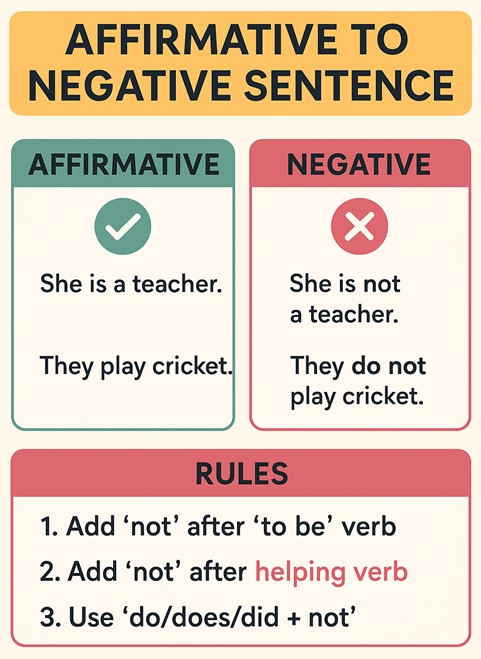Affirmative to Negative Sentence in English Grammar
(With Easy Hindi Explanation)
1. Introduction
English grammar में sentences दो प्रकार के हो सकते हैं — Affirmative (Positive) और Negative।
- Affirmative Sentence: वह sentence जो किसी बात की पुष्टि करता है (Yes कहता है)।
- Negative Sentence: वह sentence जो किसी बात को नकारता है (No कहता है)।
इसमें हम सीखेंगे कि कैसे Affirmative sentence को Negative sentence में बदला जाता है, step-by-step, आसान examples के साथ।
2. Definition
Affirmative Sentence
वह sentence जो किसी बात को positive रूप में कहता है।
Example:
- She is a teacher. (वह एक teacher है।)
- They play cricket. (वे cricket खेलते हैं।)
Negative Sentence
वह sentence जिसमें किसी बात को not या अन्य negative word के साथ नकार दिया जाता है।
Example:
- She is not a teacher. (वह teacher नहीं है।)
- They do not play cricket. (वे cricket नहीं खेलते हैं।)
3. How to Change Affirmative to Negative Sentence
Rule 1: “Be” Verb वाले Sentences में “not” जोड़ना
अगर sentence में is, am, are, was, were हो, तो इनके बाद not जोड़ते हैं।
Examples:
1. She is happy. → She is not happy.
2. I am ready. → I am not ready.
3. They were tired. → They were not tired.
Rule 2: Helping Verb वाले Sentences में “not” जोड़ना
अगर sentence में has, have, had, will, shall, can, may, must जैसे helping verb हों, तो इनके बाद not लगाएँ।
Examples:
1. He has a car. → He does not have a car. (ध्यान दें: “has” को negative में “does not have” किया जाता है)
2. She will go. → She will not go.
3. They can swim. → They cannot swim.
Rule 3: Main Verb वाले Simple Present/Past Tense में “do/does/did + not”
अगर sentence में कोई helping verb नहीं है और main verb present tense में है, तो do/does का प्रयोग करें।
अगर main verb past tense में है, तो did का प्रयोग करें।
Examples:
1. They play cricket. → They do not play cricket.
2. She likes coffee. → She does not like coffee.
3. He went to school. → He did not go to school.
Rule 4: Special Words बदलकर Negative बनाना
कुछ affirmative words को उनके negative form से बदलना पड़ता है:
|
Affirmative Word |
Negative Word |
|
always |
never |
|
everybody |
nobody |
|
someone |
no one |
|
something |
nothing |
|
all |
not all |
Examples:
1. Everybody knows him. → Nobody knows him.
2. She always comes on time. → She never comes on time.
Rule 5: Double Negative से बचना
English में एक sentence में केवल एक ही negative form इस्तेमाल करें, वरना meaning बदल सकता है।


4. Common Mistakes
1. Has को सीधे “has not” करना हमेशा सही नहीं होता
o He has a car. → He does not have a car. (Correct)
2. Verb का base form इस्तेमाल करना
o Wrong: He did not went.
o Correct: He did not go.
3. Helping verb का सही प्रयोग
o Wrong: She plays not cricket.
o Correct: She does not play cricket.
5. Practice Sentences
Convert into Negative:
1. She is beautiful.
2. They like football.
3. He has a laptop.
4. We went to the park.
5. Everyone was happy.
(Answers नीचे दिये हैं)
Answers:
1. She is not beautiful.
2. They do not like football.
3. He does not have a laptop.
4. We did not go to the park.
5. No one was happy.
6. Conclusion
Affirmative to Negative sentence बदलना आसान है अगर आप Helping verbs, “not” का सही use, और special word changes के rules याद रख लें। Regular practice से आपका English sentence formation और grammar दोनों बेहतर होंगे।
